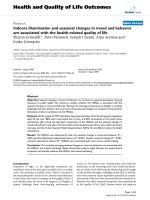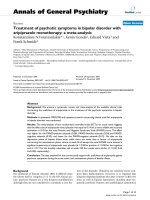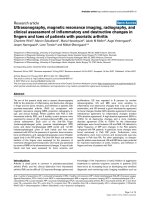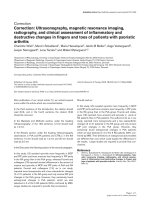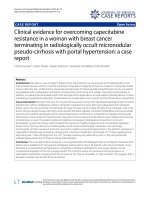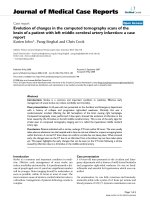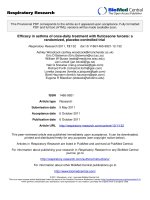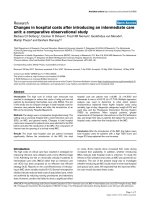Do changes in DNA methylation mediate or interact with SNP variation? A pharmacoepigenetic analysis
Bạn đang xem bản rút gọn của tài liệu. Xem và tải ngay bản đầy đủ của tài liệu tại đây (283.67 KB, 5 trang )
Fisher et al. BMC Genetics 2018, 19(Suppl 1):70
/>
RESEARCH
Open Access
Do changes in DNA methylation mediate or
interact with SNP variation? A
pharmacoepigenetic analysis
Virginia A. Fisher*†, Lan Wang†, Xuan Deng, Chloé Sarnowski, L. Adrienne Cupples and Ching-Ti Liu
From Genetic Analysis Workshop 20
San Diego, CA, USA. 4-8 March 2017
Abstract
Background: In studies with multi-omics data available, there is an opportunity to investigate interdependent
mechanisms of biological causality. The GAW20 data set includes both DNA genotype and methylation measures
before and after fenofibrate treatment. Using change in triglyceride (TG) levels pre- to posttreatment as outcome,
we present a mediation analysis that incorporates methylation. This approach allows us to simultaneously consider
a mediation hypothesis that genotype affects change in TG level by means of its effect on methylation, and an
interaction hypothesis that the effect of change in methylation on change in TG levels differs by genotype. We
select 322 single-nucleotide polymorphism–cytosine-phosphate-guanine (SNP-CpG) site pairs for mediation analysis
on the basis of proximity and marginal genome-wide association study (GWAS) and epigenome-wide association
study (EWAS) significance, and present results from the real-data sample of 407 individuals with complete
genotype, methylation, TG levels, and covariate data.
Results: We identified 3 SNP-CpG site pairs with significant interaction effects at a Bonferroni-corrected significance
threshold of 1.55E-4. None of the analyzed sites showed significant evidence of mediation. Power analysis by
simulation showed that a sample size of at least 19,500 is needed to detect nominally significant indirect effects
with true effect sizes equal to the point estimates at the locus with strongest evidence of mediation.
Conclusions: These results suggest that there is stronger evidence for interaction between genotype and
methylation on change in triglycerides than for methylation mediating the effect of genotype.
Keywords: Causal modeling, Genomic data integration, Gene-methylation interaction, Indirect effects, Triglycerides,
Genofibrate treatment
Background
Epigenetic mechanisms, including DNA methylation, are
known to influence the phenotypic consequences of genetic variation. To fully explain the biological mechanism
of an outcome of interest, it is necessary to characterize
the relationship between genetic and epigenetic effects.
These relationships may be described as mediation, in
which genetic variation influences methylation which
then influences the phenotype, or interaction (also called
* Correspondence:
†
Virginia Fisher and Lan Wang contributed equally to this work.
Department of Biostatistics, Boston University School of Public Health, 801
Massachusetts Ave. 3rd floor, Boston, MA 02118, USA
effect modification) in which the average effect of
methylation differs by genotype, or both.
Mediation analysis has been applied to epidemiological
studies of genetic and epigenetic variation to investigate
the first of these hypotheses [1, 2]. Previous studies
found evidence that methylation may mediate genetic
risk of rheumatoid arthritis, inflammatory bowel disease,
and peanut allergy [3, 4]. Gene–environment interaction
methods have also been adapted to pharmacogenetics
trials to address the second hypothesis.
The GAW20 data set reports a single-arm clinical trial
of a drug intended to lower triglyceride (TG) levels. TG
and DNA methylation are observed both before and
© The Author(s). 2018 Open Access This article is distributed under the terms of the Creative Commons Attribution 4.0
International License ( which permits unrestricted use, distribution, and
reproduction in any medium, provided you give appropriate credit to the original author(s) and the source, provide a link to
the Creative Commons license, and indicate if changes were made. The Creative Commons Public Domain Dedication waiver
( applies to the data made available in this article, unless otherwise stated.
Fisher et al. BMC Genetics 2018, 19(Suppl 1):70
Page 16 of 140
after drug treatment. In this article, we investigate the
extent to which mediation and interaction effects between
single-nucleotide polymorphisms (SNPs) and changes in
methylation at nearby cytosine-phosphate-guanine (CpG)
sites contribute to changes in TG levels. In this context,
mediation effects represent a mechanism of drug action
through context-specific methylation quantitative trait
loci, while interaction effects may identify genetic subgroups in which drug-induced changes in methylation
lead to changes in TG levels.
Methods
We analyzed the real GAW data set, comprising 407
individuals with complete TG, genotype, methylation,
and covariate data. The sample of 679 individuals
with TG, genotype, and covariate data was used for
preliminary screening of SNPs for analysis. In the
following, we present the details for an exposure A
(SNP genotype alternate allele count), a continuous
mediator M (difference in methylation posttreatment
minus pretreatment), and a continuous outcome Y
(difference in log TG posttreatment minus pretreatment). Relevant covariates C include age, sex, study
center, and smoking status.
Mediation hypothesis
The counterfactual approach to mediation analysis provides methods to quantify these relationships [5, 6]. This
approach is based on the potential outcomes of each
subject, conditional on the levels of exposure and mediator. Only one of these potential outcomes is observed
for each individual, but under certain assumptions, the
others may be estimated from the data. Here, Yam represents the potential outcome for exposure level A = a and
mediator level M = m, and M(a) represents the level of
the mediator that would be observed for a given subject
with exposure level a. The total contribution of mediation through M to the effect of A on Y is given by the
natural indirect effect (NIE): NIE ¼ Y aMðaÞ −Y aMðaÃ Þ ,
which is the difference in potential outcomes among
individuals with exposure level a compared to those with
observed mediator level M (a) and counterfactual mediator level M (a*) which they would have had if their
exposure level had been a*. For notational simplicity, we
take a = 1 and a* = 0 so the contrast is defined in terms
of 1 additional alternate allele for the SNP under consideration. Note that this quantity will be zero if there is no
effect of the exposure on the mediator [so that M(a) =
M(a∗)] or no effect of the mediator on the outcome (so
that Y am1 ¼ Y am2 for any values m1, m2 of the mediator).
The NIE can be estimated from the simultaneous regression models as follows:
E MjA ẳ a; Cẳcị ẳ 0 ỵ 1 a ỵ 2 0 c
1ị
E Y jA ẳ a; M ẳ m; Cẳcị
ẳ 0 ỵ 1 a ỵ 2 m ỵ 3 a m ỵ 04 c
2ị
Under the assumptions described below, the NIE=β1(θ2
+ θ3). The SE of this estimate via the delta method is
pffiffiffiffiffiffiffiffiffi0ffi
ΓΣΓ where Γ = (0, θ2 + θ3, 0′, 0, 0, β1, β1, 0′) and ∑ is the
block-diagonal covariance matrix of the estimators from
regression models (1) and (2).
This NIE estimator has a valid causal interpretation if
models (1) and (2) are correctly specified and the following assumptions hold:
1. No unmeasured confounding for the exposure–
outcome relationship.
2. No unmeasured confounding for the mediator–
outcome relationship.
3. No unmeasured confounding for the exposure–
mediator relationship.
4. No mediator-outcome confounder is affected by the
exposure.
Similar assumptions are required for causal interpretation of any regression analysis.
Because the statistical power to detect indirect effects
is low in studies with a small to moderate sample size,
and because statistical hypothesis testing is not a valid
method for qualitative assessment of confounding between the exposure and mediator, VanderWeele recommends comparing the magnitude of the total effect of
the exposure on the outcome, estimated from a model
that excludes the mediator, and the direct effect of exposure adjusting for the effect of the mediator and exposure–mediator interaction [6].
Interaction hypothesis
For the purpose of assessing mediation, the interaction
term in model (2) is useful primarily to allow valid estimates in the presence of non-additive contributions of
the genetic and methylation effects. However, we are
also interested in the interaction coefficient θ3 in its own
right. The null hypothesis of interaction, θ3 = 0, may be
interpreted as follows: the effect of M on Y is the same
at all levels of A. If this null hypothesis does not hold,
we may identify genotypic subgroups with different
methylation effects.
Implementation
The GAW20 real data set is drawn from a single-arm
clinical trial of fenofibrate treatment in the Genetics of
Lipid Lowering Drugs and Diet Network (GOLDN)
study family-based cohort. We selected SNP-CpG site
pairs by first running marginal association models with
the phenotype:
Fisher et al. BMC Genetics 2018, 19(Suppl 1):70
Page 17 of 140
Table 1 Top 5 most significant NIEs
SNP
CpG
SNP MAF
Chr
Distance
TE
TE
p value
NDE
NDE
p value
NIE
NIE
p value
rs12771141
cg04855826
0.359
10
12.5
0.071
3.12E − 03
1.745
0.048
0.008
0.068
rs12438405
cg21284575
0.436
15
28.8
0.064
5.29E − 03
−3.036
0.135
0.008
0.068
rs6832151
cg15003695
0.283
4
19.6
−0.074
2.77E − 03
5.253
0.008
−0.008
0.084
rs32458
cg12200124
0.329
5
39.3
0.049
0.03217
−0.272
0.398
0.007
0.088
rs11634929
cg03678138
0.041
15
8.7
−0.234
4.51E-04
−6.022
0.030
−0.054
0.089
Distance between SNP and CpG site is reported in kilobases. The natural direct effect (NDE) refers to the SNP effect that is not mediated by change in
methylation. This is estimated by the coefficient θ1 from model (2). The total effect (TE) is the SNP effect γ1 in the unadjusted regression model (3)
MAF minor allele frequency
E Y jA ẳ a; C ẳ cị ẳ 0 ỵ 1 a ỵ 2 0 c
3ị
E Y jM ẳ m; C ẳ cị ẳ 0 ỵ 1 m ỵ 2 0 c
4ị
We then selected SNP-CpG site pairs with all the
following 3 criteria:
1. SNP p value <1e-3
2. Methylation epigenome-wide association study p
value < 0.05
3. Distance between SNP and CpG site < 50 kb pairs
These criteria were chosen to balance the considerations of low statistical power resulting from multiple
testing corrections against the possibility of failing to
detect significant interactions when the marginal effects
are negligible.
The mediation–interaction model described above was
then estimated for these SNP-CpG site pairs. The total
effect refers to the coefficient γ1 in regression model (3).
Models (3) and (4) were estimated genome-wide using
EPACTS, and models (1) and (2) were estimated only at
selected SNP-CpG pairs using the kinship and coxme
packages in R.
Because of missing data in the posttreatment methylation data set, the sample for mediation analysis was a
subset of the GWAS screening sample.
Power calculations
We used simulation to investigate the statistical power
to detect mediation between genotype and change in
methylation. Based on the SNP allele frequency and
distribution of change in methylation at the SNP-CpG
site pair with strongest evidence of nonzero NIE, we
simulated genotypes, change in methylation, and outcome measures varying the sample size, effect of SNP on
change in methylation (β1), effect of methylation on outcome (θ2), and interaction effect (θ3), while holding all
other model parameters constant at their observed point
estimates. The simulated samples comprised unrelated
individuals, so the parameters in models (1) and (2) were
estimated by multiple linear regression rather than linear
mixed models. All power calculations used a significance
level of α = 0.05, with 500 replicates.
Results
Using the above criteria, 322 SNP-CpG site pairs were
selected, including 156 unique SNPs and 223 unique
CpG sites. The maximum number of significant CpG
sites within the 50-kb radius of a given SNP was 7, and
the maximum number of significant SNPs within 50 kb
of a given CpG site was 16. These numbers presumably
reflect linkage disequilibrium (LD) patterns among
nearby variants. Tables 1 and 2, respectively, summarize
the most significant mediation and interaction effects.
The Wald test for the NIE (see Table 1) reveals no
SNP-CpG pairs with significant evidence of mediation at
the α = 0.05 level. However, it is noteworthy that the
total effect and natural direct effect show opposite direction in 3 of these 5 cases, and differ substantially in magnitude in all 5. For interaction, 3 SNP-CpG site pairs
pass a Bonferroni-corrected significance threshold of
Table 2 Top 5 most significant interaction effects
SNP
CpG
SNP MAF
Chr
Distance
TE
TE p value
Int. effect
Int. p value
NIE
NIE p value
rs4686740
cg21463380
0.482
3
40.8
3.12E − 03
7.64E − 03
1.025
6.11E − 09
0.005
0.144
rs2575
cg21463380
0.482
3
47.2
5.29E − 03
9.14E − 03
0.980
3.02E − 08
0.006
0.091
rs17216446
cg15395354
0.458
4
19.0
2.77E − 03
8.50E − 04
0.624
1.41E − 06
0.003
0.257
rs1997579
cg12299303
0.118
21
39.0
0.03217
3.85E − 05
−1.339
8.95E − 04
−0.004
0.328
rs1143115
cg17140441
0.439
15
27.8
4.51E-04
3.74E − 04
0.383
1.56E − 03
0.002
0.268
Distance between SNP and CpG site in kilobases, NIE, and total genetic effects (TE) from the unadjusted model are also reported
Int interaction, MAF minor allele frequency
Fisher et al. BMC Genetics 2018, 19(Suppl 1):70
Page 18 of 140
Table 3 Methylation effect estimates stratified by genotype at SNPs with significant interaction effects
p Value
SNP
Ref. allele
Alt. allele
No. alt alleles
No.
CpG site
Beta
SE
rs4686740
A
G
0
124
cg21463380
−0.11728
0.579811
0.84
1
190
1.576491
0.558714
0.0048
2
89
1.597208
0.594223
0.0072
0
124
0.409902
0.382098
0.28
rs17216446
C
A
cg15395354
1
195
0.366537
0.338832
0.28
2
76
2.026818
0.669214
0.0025
Alt alternate, No number, Ref reference
0.05/322 = 0.000155, adjusting for multiple testing at all
selected pairs (see Table 2). For each of these pairs, the
interaction effect was more significant than the total
effect of the SNP from model (3), thereby excluding
methylation. Estimated effects of methylation stratified
by genotype are reported in Table 3, demonstrating differential responses to change in methylation. The top 2
interaction effects, both with p < 5e-8, were found with
the same CpG site, cg21463380 on chromosome 3. Two
SNPs involved in these interaction effects, rs4686740
and rs2575, are in high LD (R2 = 0.9175, D′ = 0.9675), so
we assume that they are tagging the same signal. The
lead SNP, rs4686740, is located in an intron of the gene
DGKG (diacylglycerol kinase gamma), which codes an
enzyme involved in lipid metabolism. The CpG site with
which it interacts is located over 40 kb away, near the
somatostatin coding gene SST. This finding suggests a
regulatory relationship between this methylation site and
the DGKG gene.
The second SNP-CpG pair (rs17216446- cg15395354)
with significant interaction effect is located on chromosome 4 in an intron of the gene METP1, which codes
the methionyl aminopeptidase 1 protein. The interacting
CpG site is located 19 kb away, in a long noncoding
RNA, BX647984. The first SNP-CpG site pair displays
substantial positive methylation effect estimates for individuals with 1 or 2 G alleles, but no effect of methylation
among those with homozygous reference genotype. The
second pair displays a positive effect of methylation only
for those with homozygous reference genotype at the
SNP. It is notable that positive effects are considered
deleterious in this study, as the aim of the drug treatment is to reduce TG levels. Mediation, as measured by
NIE, did not reach nominal significance (p < 0.05) at any
of the SNP-CpG sites with significant interaction effects.
In all these cases, the effect of genotype on change in
methylation, one factor in the product formulation of
the NIE, was not significant.
Figure 1 shows plots of the statistical power from simulations to detect NIE. Varying the components of the
NIE independently within the range of parameter estimates observed in the study data, all scenarios showed
power of less than 50%. The genotype effect on change
in methylation, β1, appears to be the greatest limitation
Fig. 1 Statistical power to detect NIE as a function of (clockwise from top left) adjusted effect of methylation θ2, gene–methylation interaction
effectθ3, sample size, and effect of SNP on methylation β1
Fisher et al. BMC Genetics 2018, 19(Suppl 1):70
on statistical power as increasing this parameter leads to
the greatest improvements in power to detect mediation.
Sample size is also a limitation, with 10,000 unrelated
subjects required to attain 50% power to detect NIE,
and 19,500 unrelated subjects required for 80% power,
given true effect sizes of β1 = 0.001, θ2 = − 1.661,
and θ3 = 0.713, equal to the point estimates at the
rs12771141-cg04855826 site.
Discussion
The mediation analysis did not identify significant indirect effects with changes in methylation level mediating
the effect of SNP genotype on change in TG levels. This
may be the result of the genetic architecture of lipid
traits; for example, short-term changes in DNA methylation may not be an effective mechanism for modifying
TG levels. The moderately small sample size, especially
in the real posttreatment methylation data, also limits
our statistical power to detect indirect effects. The substantial changes in direct effect estimates after accounting for possible confounding and interaction with the
nearby CpG site suggests that the effects of genotype
and methylation are not independent at these sites, despite the failure to attain statistical significance. Further
work is needed on hypothesis testing for mediation in
the context of a heavy burden of multiple testing. In particular, statistical tests for the change in effect estimates
between the unadjusted and interaction-adjusted models
would provide overall quantification of the impact of
methylation on genetic effects at a given locus. Furthermore, multiple-exposure or multiple-mediator models
may be appropriate at loci where several SNP-CpG pairs
were identified.
Conclusions
We found significant interaction effects between SNP
genotypes and CpG methylation levels on chromosomes
3 and 4. For individuals with certain genotypes, increases
in methylation at the identified CpG sites were strongly
associated with increased TG levels after drug treatment.
These findings provide evidence of regulatory relationships between DNA methylation and SNPs at these loci.
However, none of these sites showed nominally significant evidence of mediation, a consequence of a lack of
association between genotype and change in methylation. In other words, the distribution of change in
methylation is the same across genotypes, but the effect
of change in methylation differs. This paper demonstrates the utility of integrated analysis of genetic and
epigenetic data to investigate the multiple sources of
variation for complex traits.
Abbreviations
CpG: cytosine-phosphate-guanine; EWAS: epigenome-wide association study;
GAW: Genetic Analysis Workshop; GWAS: genome-wide association study;
Page 19 of 140
LD: linkage disequilibrium; NIE: natural indirect effect; SNP: single nucleotide
polymorphism; TG: triglyceride
Funding
Publication of the proceedings of Genetic Analysis Workshop 20 was
supported by National Institutes of Health grant R01 GM031575.
Availability of data and materials
The data that support the findings of this study are available from the
Genetic Analysis Workshop (GAW), but restrictions apply to the availability of
these data, which were used under license for the current study. Qualified
researchers may request these data directly from GAW.
About this supplement
This article has been published as part of BMC Genetics Volume 19
Supplement 1, 2018: Genetic Analysis Workshop 20: envisioning the future of
statistical genetics by exploring methods for epigenetic and
pharmacogenomic data. The full contents of the supplement are available
online at />Authors’ contributions
VF, LW, XD, CS, LAC, and CTL designed the study. VF, LW, and XD performed
analysis. VF prepared the manuscript, and all authors reviewed and edited it.
All authors read and approved the final manuscript.
Ethics approval and consent to participate
Not applicable.
Consent for publication
Not applicable.
Competing interests
The authors declare that they have no competing interests.
Publisher’s Note
Springer Nature remains neutral with regard to jurisdictional claims in
published maps and institutional affiliations.
Published: 17 September 2018
References
1. Millstein J, Zhang B, Zhu J, Schadt EE. Disentangling molecular relationships
with a causal inference test. BMC Genet. 2009;10:23.
2. Bjornsson HT, Sigurdsson MI, Fallin MD, Irizarry RA, Aspelund T, Cui H, Yu W,
Rongione MA, Ekström TJ, Harris TB, et al. Intra-individual change over time
in DNA methylation with familial clustering. JAMA. 2008;299(24):2877–83.
3. Liu Y, Aryee MJ, Padyukov L, Fallin MD, Hesselberg E, Runarsson A, Reinius L,
Acevedo N, Taub M, Ronninger M, et al. Epigenome-wide association data
implicate DNA methylation as an intermediary of genetic risk in rheumatoid
arthritis. Nat Biotechnol. 2013;31(2):142–7.
4. Ventham NT, Kennedy NA, Adams AT, Kalla R, Heath S, O’Leary KR,
Drummond H, IBD BIOM consortium; IBD CHARACTER consortium, Wilson
DC, et al. Integrative epigenome-wide analysis demonstrates that DNA
methylation may mediate genetic risk in inflammatory bowel disease. Nat
Commun. 2016;7:13507.
5. Fairchild AJ, MacKinnon DP. A general model for testing mediation and
moderation effects. Prev Sci. 2009;10(2):87–99.
6. VanderWeele T. Explanation in causal inference: methods for mediation and
interaction. New York: Oxford University Press; 2015.

